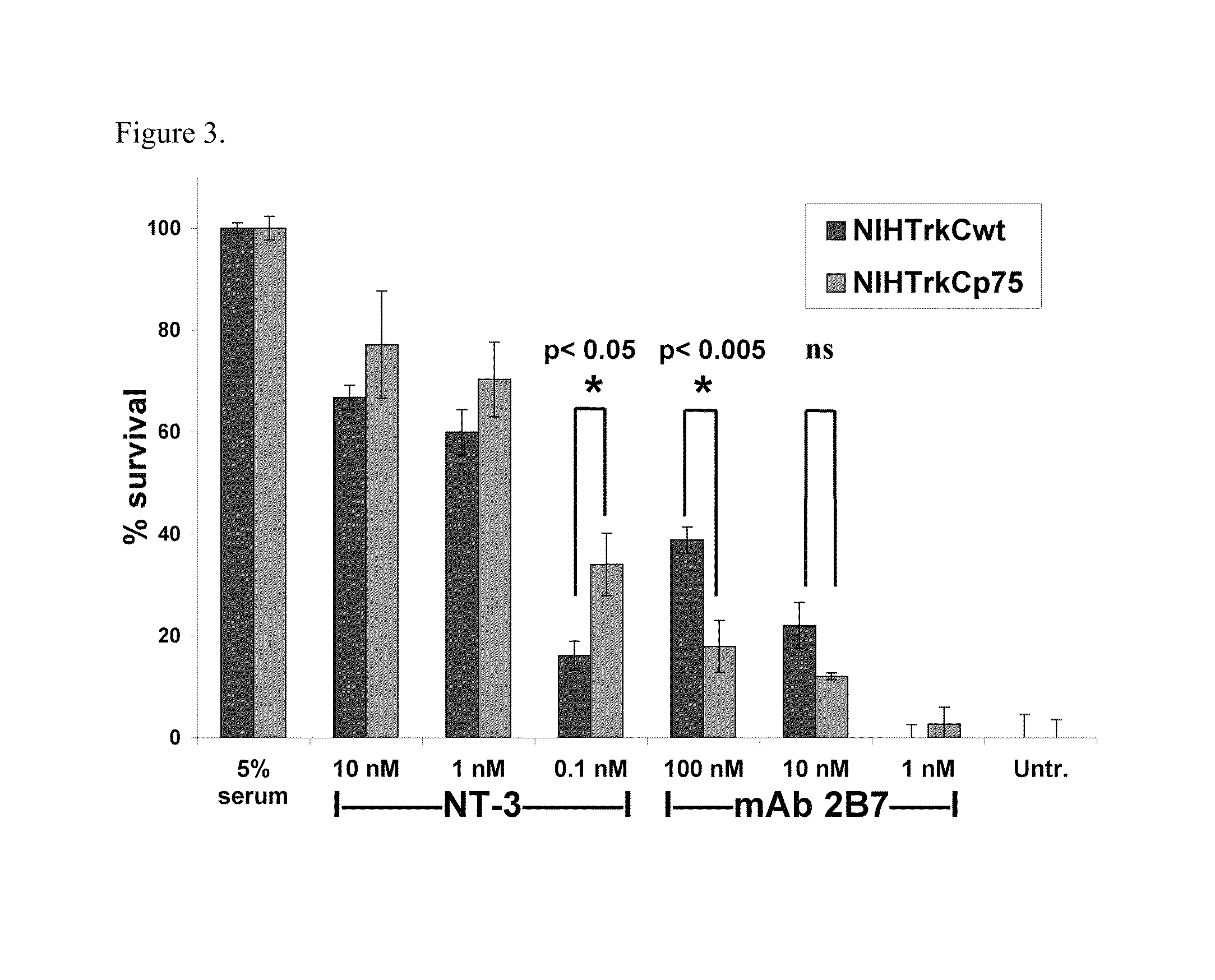Agonistic antibodies to TrkC receptors and uses thereof
a technology of trkc receptor and agonistic antibodies, which is applied in the field of monoclonal antibodies, can solve the problems of shortening patient survival by several months, weak muscle weakness and atrophy throughout the body, and presently no cure for als, so as to increase the total length of neurites, increase the length, and improve the morphology of dendrites.
- Summary
- Abstract
- Description
- Claims
- Application Information
AI Technical Summary
Benefits of technology
Problems solved by technology
Method used
Image
Examples
example 1
Generation and Initial Screening of mAb 2B7 Binding
[0110]Linear peptide NH2-ESTDNFILFDEVSPTPPI-COOH (SEQ ID NO: 1) was conjugated through the N-terminus to KLH, and was used to immunize mice. After fusion of splenocytes with SP2 myeloma cells, culture supernatant from hybridomas was screened by ELISA using either the immunizing peptide conjugated to BSA, or free peptide immobilized on the ELISA plate. Several independent wells with hybridoma cells producing antibodies with selectivity to the immunizing peptide were identified, and they were subcloned three times by limiting dilution. MAb 2B7 was chosen for further work.
example 2
Characterization of mAb 2B7 Binding
[0111]To assess mAb 2B7 specificity for cell surface TrkC, cells expressing or lacking TrkC were screened for differential binding by FACScan.
[0112]MAb 2B7 binds strongly to NIH-TrkC transfectants (FIG. 1C) and nnr5-TrkC transfectants (FIG. 1F). In controls, it does not bind to wild type NIH-3T3 cells (FIG. 1A), NIH-TrkA transfectants (FIG. 1B), or wild type nnr5 cells (FIG. 1E) above mIgG background control. In additional assays mAb 2B7 does not bind to SY5Y cells transfected with human TrkB cDNA (data not shown). Binding of mAb 2B7 to non-permeabilized cells indicates that it recognizes the extracellular domain of TrkC. The specific epitope on TrkC is located between the transmembrane and the D5 domain. Therefore, mAb 2B7 binds selectively to native TrkC on the cell surface; near the juxtamembrane region; and it does not bind to p75, TrkB, or TrkA.
[0113]The concentration of mAb 2B7 and mAb 2B7 Fab required for saturation of TrkC (FIG. 1I) is ˜65 ...
example 3
Ligand Competition Studies
[0115]FACScan analysis demonstrated that NT-3 blocks, in a dose-dependent manner, mAb 2B7 binding sites. NT-3 at 1 nM blocks ˜40% of the mAb 2B7 binding sites in NIH-TrkC (FIG. 1G) and in NIH-TrkC+p75 cells (FIG. 1H; see Table 1 for a summary). Thus, mAb 2B7 binds to a receptor hot spot topologically related to the NT-3 binding site, but which is outside the known NT-3 binding site demonstrated to be exclusively at the D5 domain of TrkC. The block of NT-3 upon 2B7 binding could be due to steric inhibition or allosteric inhibition. These results suggest that assays to screen for agents that inhibit mAb 2B7 binding to TrkC can be used to identify TrkC ligands.
[0116]Table 1 shows a summary of FACScan data from FIGS. 1G and 1H. Raw mean channel fluorescence (MCF) for a single experiment is shown, and mAb 2B7 inhibition of binding by NT-3 are presented as % inhibition±sem, n=3 independent experiments. Mouse IgG is used as background control (no binding). MAb 2B7...
PUM
 Login to View More
Login to View More Abstract
Description
Claims
Application Information
 Login to View More
Login to View More - R&D
- Intellectual Property
- Life Sciences
- Materials
- Tech Scout
- Unparalleled Data Quality
- Higher Quality Content
- 60% Fewer Hallucinations
Browse by: Latest US Patents, China's latest patents, Technical Efficacy Thesaurus, Application Domain, Technology Topic, Popular Technical Reports.
© 2025 PatSnap. All rights reserved.Legal|Privacy policy|Modern Slavery Act Transparency Statement|Sitemap|About US| Contact US: help@patsnap.com



